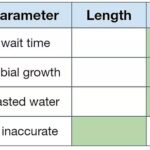
Quality Control in Engineering Designs
Engineers working in design know that quality control places significant demands on their work. From pipe sizing to pressure calculations, engineers must be able to quickly deliver quality systems that are accurate, compliant, and work for the client’s needs.

Engineers working in design know that quality control places significant demands on their work. From pipe sizing to pressure calculations, engineers must be able to quickly deliver quality systems that are accurate, compliant, and work for the client’s needs.
h2x is a design tool that helps engineers improve their systems’ quality. It provides users with design warnings, automated calculations, a centralised space to share and amend their designs, and can be fully integrated into AutoCAD and Revit..
In this article, we take a deep dive into;
- The importance of quality control
- How to transform design and calculation methods
- Increasing the efficiency of design iterations
- Issues with current internal and external review processes
- How H2X can help ensure quality targets are met. Let’s get started.
Suggested reading: For an in-depth exploration of the role of software in quality control, take a look at our free heat pump eBook — ‘Everything You Need to Know About Heat Pumps’.
What is quality control?
Quality control ensures that completed work meets the expectations agreed upon at the outset of a project. Whilst sometimes used interchangeably, quality assurance and quality control are separate terms:
- Quality Assurance (QA): Refers to quality management assumptions and how these will be achieved.
- Quality Control (QC): This concerns the plan and procedures you will follow to achieve high-quality outcomes, which are present throughout all phases of the project. Some methods of QC could include employing a quality management system (QMS), statistical process controls (SPCs), or efficiency-driving software.
Why quality control in engineering matters
If quality control requirements are not met, projects often face complications:
- Added costs: One study suggested that construction project design errors resulted in direct costs roughly equal to 6.85% of the contract value — without proper quality control, costs can quickly escalate.1
- Safety issues: Incorrect pressure and velocity measurements can result in dangerous system failures.
- Damaged reputation: Systems that don’t work are evidence of design failure. Not only is this damaging to the engineer’s reputation, but it is also damaging to the company.
Quality control improves client satisfaction, meaning the engineer is more likely to receive future work.
Moreover, high-quality work can prevent rework times, which:
- Reduces costs
- Ensures your project remains on schedule
- Keeps your team’s morale high
- Boosts productivity
Remember, quality control and cost control are not mutually exclusive. When you plan and establish quality standards early on, you can substantially reduce the risk of mistakes, and their associated cost, further down the line.
Designing and calculating
Traditional design and calculation methods can be incredibly tedious. They typically involve markups, rulers, and transferring data to and from Excel, while continually sharing this information with other team members.
This design and calculation method puts several aspects of quality control at risk. Leaders may lack visibility of what changes are being made, and, in the process, lose track of their team’s progress. This can result in:
- Abandonment of procedure: when visibility is lost, the next thing to go is almost always procedure. Team members might begin using informal calculation methods, exposing their designs to the risk of error.
- Human error: just one mistake can have a catastrophic effect on a project, multiplying across the system design and leading to poor quality, and potentially dangerous results.
- Time-consuming amendments: particularly if a design or calculation error occurs at the start of a project, it can take a long time to locate and resolve the issue.
h2x and compliant design
With h2x, this entire process is simplified. It allows users to easily calculate their system’s velocity, pressure and flow rates, ensuring compliance is maintained at all times. When using h2x, all a user has to do is:
- Input their design parameters
- Develop their design by inputting pipes, nodes, vents and more
- Review their results, adjusting the design according to design warnings
By eliminating the risk of human error, h2x allows engineers to save time, reduce costs, and produce high-quality designs.
Suggested reading: Read the case study of Greengate, Manchester UK, to discover how H2X improved efficiency by an estimated 50%.
Iterating the design
Iterations are an inevitable stage of any systems engineering process. Whether due to changing client specifications or architect redesigns, they can make it difficult for engineers to keep costs low, while maintaining design quality.
In traditional designing methods, engineers are faced with only two iteration options:
- Start the design process again.
- Be conservative in initial calculations, so that changes can be made more easily later on.
Neither of these solutions is perfect. The evolution of design iteration demands engineering processes that can cope with constant change, development, and adjustment.
h2x: making iterations easy
Made by engineers, H2X is designed to make iterations quick and easy.
After receiving an iteration, all an engineer has to do is change the design layout, which will instantly update the system calculation results.
Without going through the tedious and often repetitive process of designing and redesigning, engineers have more time to focus on the quality and efficiency of their systems.
Performing internal reviews
Performing internal reviews is an easy way to ensure quality control is maintained. Depending on the length of the project, teams might choose to take weekly, monthly, or six-monthly reviews, which allow team leaders to assess whether the quality of the work is meeting internal and external targets.
However, there is a right and wrong way to perform these reviews. Some common issues internal design reviews face are:
- Lack of clarity: multiple versions of designs across different devices can make it difficult for teams to correlate inputs and results between spreadsheets and the design markup.
- Simple mistakes: if designs are harder to access and review, final system designs will be more prone to error.
- Miscommunication: if clear communication channels are not established early on, internal reviews will be governed by miscommunication, confusion, and potential conflict.
h2x and the review process
h2x is, first and foremost an engineering design tool made to ensure the quality, compliance, and accuracy of engineering work.
However, it is also defined by its focus on collaborative working.
h2x offers a CIBSE calculation software that helps to ensure consistent outcomes across teams. Results are shown on each component, and the calculations can be viewed for additional clarity.
With h2x, internal reviews can be managed more efficiently as lead engineers have direct access to their team’s designs, results, and calculations. Not only can this help prevent miscommunications and errors, but it can also help quality control procedures function more effectively.
Performing external reviews
Like internal reviews, external reviews are essential to maintaining quality control and ensuring that clients are happy with the progress of their design.
Typically, an external review process might look something like this:
- Send an excel file to a customer via email.
- Receive a response or multiple responses asking for more information.
- Respond with information, or amend the design according to client requests.
- Organise a face to face review or undergo a written review procedure.
It’s not uncommon for engineers to receive several requests for information (RFIs), meaning more time has to be spent sending documents with updated versions.
Although excel files may seem easy to understand for engineers, this is not always the case for clients. User-friendly and easily shareable designs are essential for improving customer-engineer communication and, in turn, improving quality control measures.
Improve customer satisfaction with h2x
h2x simplifies the process of external review by eliminating the need for RFIs. Customers can easily view the live design, as well as the calculations behind it; as a result, the external review process will look more like this:
- Notify the customer that their design is ready for review.
- The reviewer views the design, and gains a clear understanding.
- There are little to no RFIs because the reviewer can see the calculations have been undertaken to a high level of detail, with the accuracy verified by CIBSE.
With a user-friendly and visually impressive interface, customers can get a real idea of what their design will look like. They can offer more high-quality feedback that allows the final product to be delivered more quickly.
Suggested reading: Read our article, H2X vs Spreadsheets, to learn more about how h2x can transform your working processes.
Getting consistent outcomes
Getting consistent outcomes is no easy task when working within a diverse engineering team. Each team member will have their own processes, methods, and standards, making it difficult for lead engineers to present work to clients in a uniform format.
Though it might not be detrimental to present clients with inconsistently formatted files, it can reflect badly on the processes within your organisation.
Furthermore, inconsistent outcomes can make parts of quality control more difficult to follow, as team members alike struggle to follow the same processes in different programs.
h2x: Live, consistent designs
From calculations to exports, h2x allows engineers to ensure consistency across the board. This helps to:
- Maintain quality control with uniform calculation and design procedures.
- Improve communication across the team.
- Impress clients with easy-to-understand layouts and process improvements.
- Make it easier for clients to assess their designs.
Collaborating with your team
Collaboration and quality control are two sides of the same coin — quality control in engineering cannot be effective if there’s no clear communication on policy, compliance and team expectations.
But with engineering turnover rates and skills shortages high, it’s important that collaboration isn’t just with your existing team, but with the team you expect to have in a year’s time.2
When a team member joins or leaves their company, lead engineers need to ensure that projects can continue to run seamlessly. The first step to improving the productivity of your engineering team is enabling long-term collaboration.
h2x and collaboration
Technology can enhance quality control management and monitoring by offering features such as automation, accessibility and visibility.
h2x simplifies the process of employee handover by holding designs within a shared, consistently formatted database. It becomes easier to train new employees according to straightforward and uniform processes, and keep track of when projects were last edited.
If a team member leaves, it is easy for another engineer to pick up and continue the project without expensive rework.
Suggested reading: Discover how h2x compares with other collaborative software by reading our article, 4 Hevacomp Alternatives in 2023 | H2X Engineering.
Revit
Revit is a great resource for modelling accurate and visually engaging designs. Almost all engineers have experience using it, creating an industry-standard format that can be understood by clients and designers alike.
However, during the coordination process, calculations can easily become outdated, placing more pressure on in-depth quality control procedures.
h2x and Revit
h2x offers Revit integration, allowing engineers to keep using the software they love without facing typical coordination challenges.
With h2x, calculations are linked throughout coordination so that all results are up to date with changes in the design. This integration:
- Improves the efficiency of workflow.
- Prevents information from falling between the cracks when designs are passed between the engineer, drafter, and client.
- Ensures users have access to the latest design updates.
Enhance quality control with h2x
Designed by engineers frustrated by legacy spreadsheet procedures, h2x ensures detailed and accurate calculations that facilitate quality control.
h2x not only provides users with compliant and accurate designs, but it does also so faster and more efficiently than other solutions. With H2X, users can instantly share their designs for a more rapid review process.
Whether you want to improve your existing quality assurance and quality control processes or are looking to improve project visibility across your team, H2X can help. Book a demo with us today.
h2x: All-In-One Tool for Calculating, Designing, Estimating, and Paperwork

What's in the Pipeline?
Get technical resources delivered to your inbox weekly!
Testimonials
What Installers Say
What Consultants Say
A game changer for the humble plumber. Incredible.
Brad Winkel
Director at Queenstown Plumbing
Brilliant, simple and easy to use. Game changer.
James Major
Director at Hubb
Big time game changer to the industry!
Viv Jude
Director at UHC
Incredible software! Super user-friendly and allows you to save so much time.
Devni Gamage
Engineer at DMA
h2x is great software, our company use it nearly every day. It is easy to use with direct conversion from h2x to Revit.
Callum Craig
Engineer at WDE
h2x is fantastic software. It is very easy to use and the ability to output to Revit is a fantastic time saver.
Joe Kirrane
Engineer at MEP













